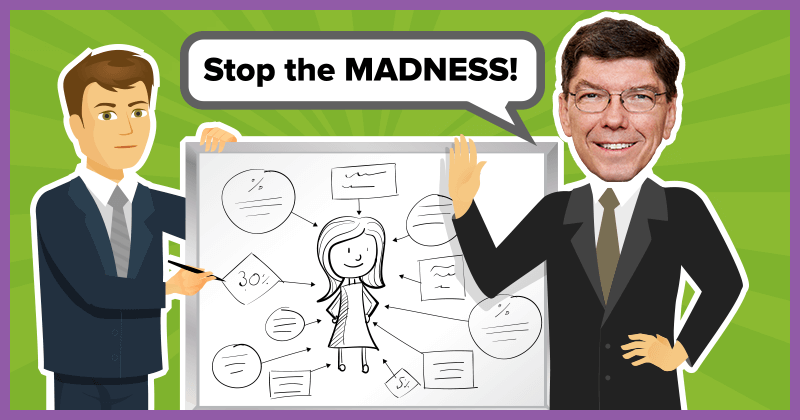
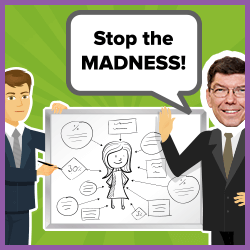
Want to get more customers?
Want your current customers to stay with you longer?
Of course you do. Gaining and retaining customers is what makes your business viable and sustainable.
So how do you do it? How do you get more customers and make them stay longer?
My advice: Start by learning exactly WHY people are buying from you!!
Have you learned this yet?
Do you know, for example, what caused your most recent customer to buy from you? Do you know the full story? Do you know:
- the circumstances that pushed the customer toward you in the first place
- the anxieties that made them hesitate
- the tipping point that made them finally pull the trigger and buy
Do you know these details?
If your answer is "No" or even "Yeah, kinda" then this post is for you. In the paragraphs that follow, I will show you a framework that will help you identify the true cause that is driving customers to buy from you.
And I promise: it has nothing to do with customer personas!
Marketing to Customer Personas is Useless! Do THIS Instead
Let's begin with some interesting facts:
Fact #1: Eating less margarine CAUSES lower divorce rates in Maine.
Counter-intuitive? Yes.
True? Of course! Here's the data:
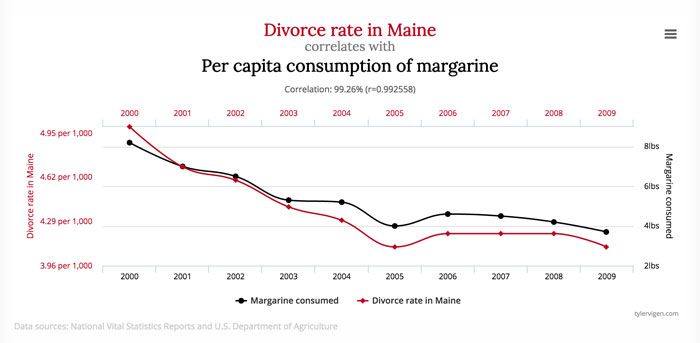
Fact #2: Eating more cheese CAUSES more Americans to die from bed-sheet entanglement.
Counter-intuitve? Again, yes.
But also true. Here's the proof:
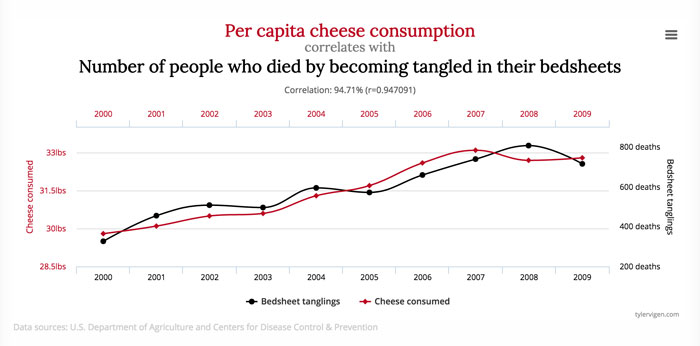
Fact #3: Being female, aged 40-44, self-employed, with an income of $75k CAUSES people to buy our app: Post Planner.
No graph on this one, but I've got the data to support it:
Over 40% of Post Planner customers are:
- female
- aged 40-44
- self-employed
- making around $75
So there you have it!
These are cold, hard facts, people!... Right?
Wrong. They are not.
Why not?
It's simple: CORRELATION DOES NOT EQUAL CAUSATION.
Let's look at each "fact" more closely.
In the case of Fact #1, falling levels of margarine consumption might be correlated with falling levels of divorce rates in Maine. But the lower margarine consumption did not CAUSE the drop in divorces.
Same thing for Fact #2. Higher levels of cheese consumption might be correlated with more Americans getting tangled to death (is that a term?) by bed sheets. But the eating of the cheese certainly did not CAUSE the deaths.
And Fact #3 is no different:
Being female, aged 40-44, self-employed, with an income of $75k might be correlated with people buying our app, Post Planner. This is undoubtedly true. Again, we know that over 40% of Post Planner customers are self-employed women of those ages and income levels.
But the ages, incomes levels, self-employed status, and female gender of the customers did not CAUSE them to buy our app.
Not at all.
The cause of their purchases was something entirely different.
Correlation Does NOT Equal Causation
"Female, aged 40-44, self-employed, with an income of $75k"
This description should look familiar to you. It's what marketers call a "customer persona."
You've probably created one for your own business -- to describe your own "typical customer."
Great! But if you think this customer persona tells you anything about why people are buying from you, then I'm afraid you are mistaken.
Remember: correlation does NOT equal causation.
- Being in a specific demographic does not CAUSE people to buy from you
- Having certain interests does not CAUSE people to buy from you
- Being in a certain industry does not CAUSE people to buy from you
Sorry, but they don't.
And no matter how often you tell yourself they do -- I promise, they don't.
These demographic attributes might be correlated with purchases of your products and services (just like margarine consumption is correlated with divorce rates in Maine), but they DO NOT cause the purchases.
So let’s stop acting like they do!
Most importantly: Let’s stop marketing our products and services like they do!
If you want to get more customers and keep them longer, then it’s time to put customer personas, demographics and interests in their proper place. They do not belong at the foundation of your marketing and product development!
Instead, let's try to figure out what truly causes people to buy from you.
Have you figured this out? Do you know it?
Do you know what caused your last customer to hand over their credit card? Do you know the full story? Do you know what tipped the scales?
You should. Because if you can identify that precise cause, you will have the most important information your business could possibly have. And you'll be able to use it to:
- Improve your marketing messages -- which will increase your conversion rates and lower customer acquisition costs (CAC)
- Improve your products and services -- which will increase engagement and retention (and decrease churn!)
- Grow your business -- in a strategic and sustainable way (long-term growth, not short-term!)
I want to step back and tell you a story.
Last spring, with the help of our newly hired CMO, Rebekah Radice, we invested a significant amount of time researching and defining our Post Planner customer persona.
Like you, we were looking to get more customers and keep them longer.
So Rebekah dove in and came up with a detailed, data-driven, research-backed customer persona -- our so-called “typical Post Planner customer.”
Here’s what it looked like. (We even named her!)
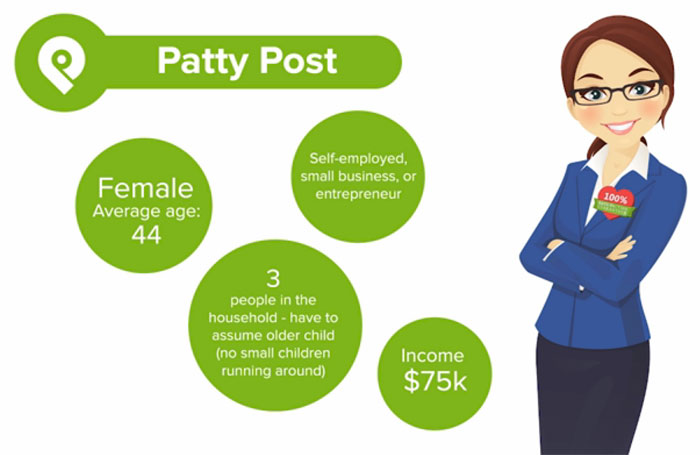
Beautiful, right?
I thought so too at the time. In fact, I was super excited to see it all laid out like this. It seemed like we had accomplished something important.
But then, once the team's high-fives stopped, and we started to think clearly about it, we realized we had no idea what to do with the new information.
We thought: How is this information actually going to help us?
How will it help us:
- Improve our marketing messaging?
- Improve our product?
- Grow our business?
And honestly, we couldn't come up with any compelling answers.
We'd invested all this time and effort into a customer persona, and the information we gained was completely inactionable.
Bummer!
Total bummer!
But luckily, that same week I was listening to a cool new podcast called Product People where host Justin Jackson was interviewing Des Traynor, the head of product at Intercom.
Shortly into the interview, Des mentioned something called “Jobs to be Done.” Then he explained it and how it had transformed marketing and product development at Intercom.
Looking back on it now, I can honestly say that listening to that podcast that day was a watershed moment in my business life. It shifted my mind in a dramatic and irreversible way.
After listening to Des explain Jobs to be Done (JTBD) and its effect on Intercom, I was completely transformed.
When I got home, I went on a JTBD rampage!
I devoured every last bit of content I could find on it, from blogs to Wikipedia to more podcasts and interviews.
Here’s what I learned:
JTBD is a framework for discovering what causes customer purchases. It helps you figure out what causes people to buy things.
The premise is that people hire products and services to do specific jobs for them. These jobs are often counter-intuitive and difficult to know without talking to the customers who are hiring them.
To show you what I mean, check out this 4-minute video with Harvard professor Clay Christensen. Clay was one of the original creators of the JTBD framework.
Awesome, right?
So basically, a fast food joint (we'll call it McDonald's for simplicity) wanted to sell more milkshakes, but they couldn't figure out how. They tried different flavors, ingredients, packaging, marketing messaging. They targeted different demographics and interests. But nothing worked. Nothing moved the needle.
Why?
Because none of those things had anything to do with why people were hiring the milkshakes!
So why were people hiring milkshakes?
According to the customers, they were hiring milkshakes to do these jobs:
- "Help cure my boredom during morning commute"
- "Fit in one hand while I'm driving"
- "Not make a mess in my lap while I drive"
- "Take over 20 min to consume" (entire commute time)
- "Not make me have to pee after drinking it"
- "Fill me up till lunch"
Notice anything about these jobs?
Well for one thing, no other item on the McDonald's menu is capable of doing all these jobs. The milkshake is literally the only qualified candidate.
And THAT, my friends, is why customers were hiring milkshakes every morning.
THAT is the cause of milkshake purchases!
Digest that for a sec... then think about this:
Knowing what they know now about why people are buying their milkshakes, what advantages does McDonald's have over their competitors?
Answer: MASSIVE advantages!
Howso?
Because McDonald's can now pull the levers on the factors that actually cause customers purchases. And they can do this while their competitors waste time trying to improve the things that don't matter!
For example, McDonald's can optimize their marketing messages based on the jobs customers are hiring milkshakes for:
- "The perfect meal for your commute"
- "Keeps you full till lunch"
- "One-handed breakfast that won't mess up your car"
McDonald's can optimize the product based on the jobs customers are hiring the milkshakes for:
- Straw width: to optimize flow, time to consume
- Cup size: to make easier to hold, fit in cupholders in cars
- Cup security: to decrease spills when dropped
- Ingredients: to make more/less filling and less diuretic
Imagine McDonald's pouring time and resources into all these high impact optimizations.
Then imagine their competitors (Burger King, Wendy's, etc.) wasting their time and resources doing things like:
- testing new flavors and packaging (which customers don't care about)
- adding meal combos (which customers don't want)
- testing marketing messages about these things (which customers don't care about)
If McDonald's is optimizing all the things that matter while their competitors are optimizing things that don't matter, who do you think will gain and retain more customers? Who do you think will dominate the industry?
McDonald's will.
And as long as their competitors don't learn the same information McDonald's knows about the jobs customers are hiring milkshakes to do, then McDonald's will be untouchable.
I want YOU to be untouchable too.
I want you to dominate your industry.
Step ONE to doing this is to figure out the causal reasons why customers are buying from you. In other words, stop with the damn "customer personas" and start thinking about the job to be done!
Figure out what jobs your customers are hiring your products/services to do for them.
You can do this the same way Clay and his crew did it for McDonald's:
Talk to customers!
Only your customers who are actually buying your products will have the information you need. So talk to them and get that info!
Step ONE: Customer Interviews
Customer interviews are the core of the JTBD framework. In fact, they are so important that they even have their own jargon: JTBD customer interviews are called “switch interviews.”
Why “switch”?
The idea is that whenever we hire a new product or service to do a job, we’re basically switching from one solution to another.
We FIRE one solution and HIRE another.
The goal of interviewing customers (the goal of the “switch interview”) is to discover WHY. We want to discover WHY exactly a customer made the switch.
The best way to do this is to get the customer to tell you the entire story of their switching process. You want them to narrate that story to you like a documentary film.
If you do it correctly, you'll be able to focus in on a specific moment in the story called the "struggling moment."
The Struggling Moment
The struggling moment is the moment when a person realizes:
- the NEED: that they need a new solution
- the JOB: what the new solution must do for them
It's the moment they realize they need a job to be done!
So how do you get the customer to give you this struggling moment in an interview?
It’s actually not that complicated. You just need to get the customer to tell you the story about why and when they switched to your product (or switched away from it).
And you need to get enough info to cover in 4 key events -- the 4 events that JTBD practitioners call the "forces of progress."
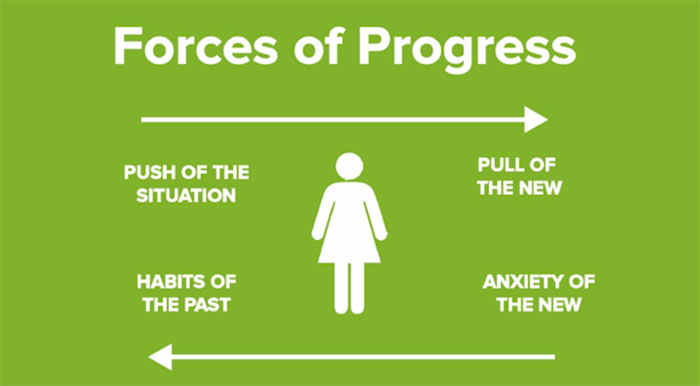
1. The PUSH of the situation
This is the situation that triggers the first thought of "I need something new! This just isn't working!" During your interviews, try to get your customer to talk through this moment and what pushed them toward the new solution.
(ie. What about their life situation led them to think they needed a better way to do something?)
2. The PULL of the new
This happens when they encounter a possible solution and it begins to pull them toward it. For example, a new product or service sets off an inner dialogue of “Hmm… this could be cool!”
PUSH and PULL are the 2 forces that promote a new action. The next 2 forces block a new action.
3. The ANXIETY of the new
This is the fear that people feel about making a change in their life. They start asking themselves questions like: “Is it going to work?” or “Am I going to regret this?”
ANXIETY sets in after the PUSH and PULL move the person close to an action (to making the switch and buy).
4. The HABIT of the past
This is the force that tugs us back to the status quo -- to business as usual. It’s the habit of the past that a customer must leave behind in order to take action and make the switch.
These 4 forces are present in every significant purchase we make. If you can get your customer to narrate these moments to you, then you will definitely uncover the struggling moment!
And then you will have your cause!
And once you have the true *cause* of why customers buy from you, you can start optimizing your marketing and product to serve that cause!
The Impact of JTBD at Post Planner
At Post Planner, this framework has had a MASSIVE impact on everything we do. In fact, the impact is still reverberating throughout our business and causing important changes.
Here’s what we’ve changed so far:
1. Systematic Customer Interviews
We created a systematic process whereby we have a continuous stream of mini "switch interviews" flowing into our business via Slack.
Our support king and blogger, Scott Ayres, now spends 50% of his time on “consultations" where he does these mini switch interviews, and then teaches the customer how to use the app.
We also started sending automated emails to every new user a few days after getting started. In the email, we ask users what they were struggling with that led them to Post Planner.
This stream of info helps us improve everything from marketing to product development to support. It affects everything from fine-tuning our email campaigns to our selection of new features.
Again, we have a Slack channel (the #jobs_to_be_done channel!) devoted specifically to these switch interviews. Every person in our company is a member of this channel, so everyone can see (in real time!) why our customers are hiring us.
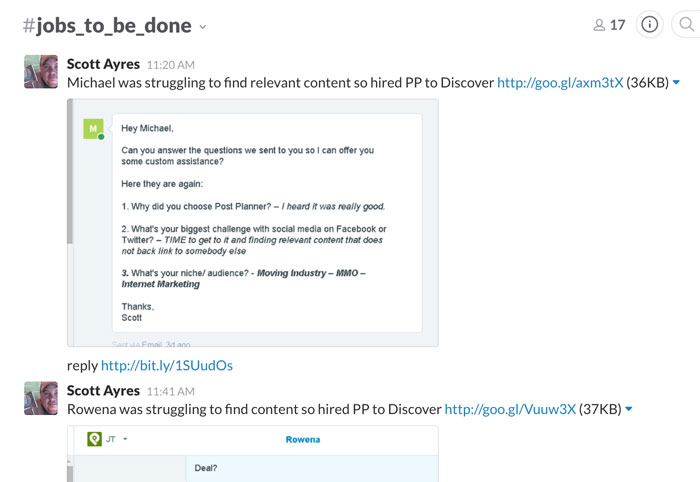
2. 100% JTBD Focused Marketing
We align all inbound campaigns and content marketing (including social media marketing) to our main jobs that customers hire us for.
This means all of our content is connected to a job our app can actually do.
For example, one thing people hire Post Planner to do is help them grow their Facebook and Twitter accounts:
We're so excited to announce the launch of the 30 Day Facebook Challenge... TODAY!Our step-by-step guide shares...
Posted by Post Planner on Wednesday, February 17, 2016
3. 100% JTBD Focused Website
The messaging on our home page and throughout the website is all JTBD focused. It takes potential customers down the path to hiring us to do specific jobs.
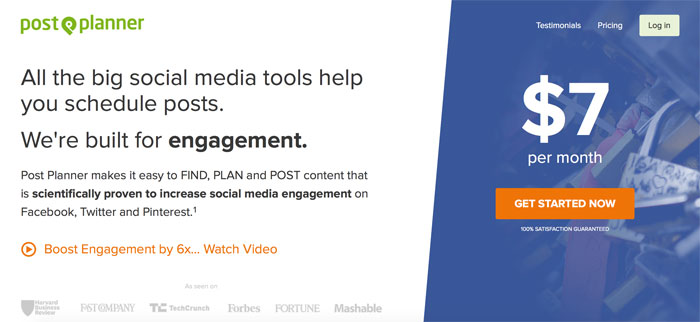
4. 100% JTBD Focused Product
Our 3 main jobs that customers hire us for are:
- Find content to create social media posts
- Plan the posts out into the future
- Post them on Facebook and Twitter
So these are the 3 main sections in our product:
FIND, PLAN, POST!
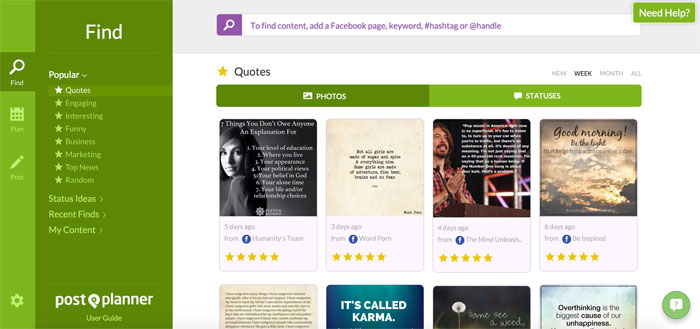
Conclusion
Going back to what I said in the beginning of this post -- if you are trying to gain and retain more customers, then you NEED to start concentrating on causation, not correlation.
You need to figure out WHY customers are hiring you, and stop getting distracted by WHO is buying from you.
You need to concentrate on the job-to-be-done, not on customer personas!
Do this and I promise you will see big improvements in your business practices, from marketing to product development.
If you dig deep into the reasons WHY customers are buying from you, you'll be able to build and market the products and services that customers actually WANT!
[This post is based on a presentation I gave at Kim Garst's Social Boom conference in the fall of 2015. You can watch the presentation in the video below. Enjoy and let me know in the comments if you have questions.]
Image Source: Spurious Correlations
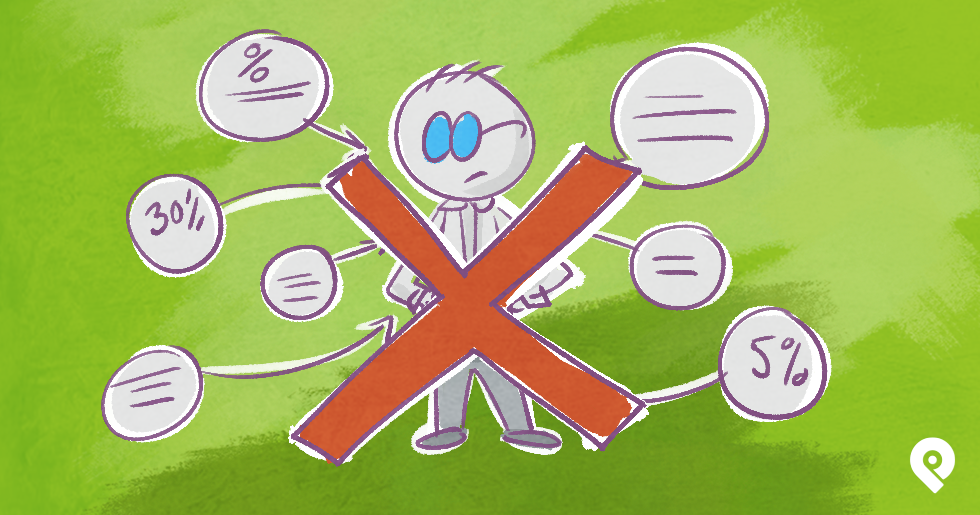
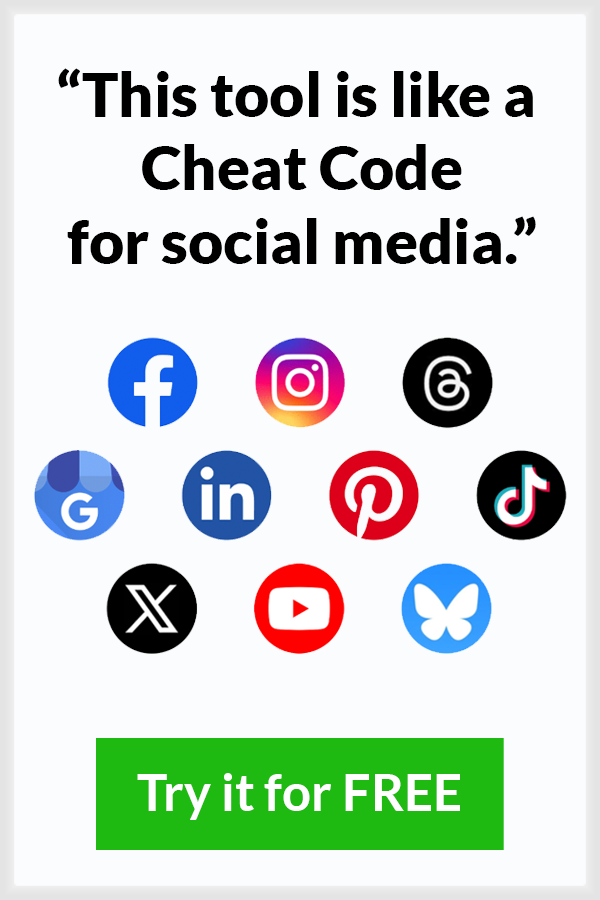





ViewHide comments (2)